A Practical Method for Red-Edge Band Reconstruction for Landsat Image by Synergizing Sentinel-2 Data with Machine Learning Regression Algorithms
Abstract
1. Introduction
2. Materials and Methodology
2.1. Remote Sensing Data
2.2. Land Surface Reflectance Conversion
2.3. Red-Edge Prediction Modeling and Performance Evaluation
3. Results
3.1. Consistency Analysis of OLI and MSI Spectral Bands
3.1.1. Comparison of TOA Reflectance with Different Resampling Algorithms
3.1.2. Comparison of BOA Reflectance with Different Atmospheric Correction Algorithms
3.2. The Simulated Red-Edge Bands and Consistency Assessment
3.3. The REIs Derived from Simulated LRE Bands and Consistency Assessment
4. Discussion
5. Conclusions
Author Contributions
Funding
Institutional Review Board Statement
Informed Consent Statement
Data Availability Statement
Conflicts of Interest
References
- Belward, A.S.; Skøien, J.O. Who launched what, when and why; trends in global land-cover observation capacity from civilian earth observation satellites. ISPRS J. Photogramm. Remote Sens. 2015, 103, 115–128. [Google Scholar] [CrossRef]
- Irons, J.R.; Masek, J.G. Requirements for a Landsat Data Continuity Mission. Photogramm. Eng. Remote Sens. 2006, 72, 1102–1108. [Google Scholar]
- Masek, J.G.; Wulder, M.A.; Markham, B.; McCorkel, J.; Crawford, C.J.; Storey, J.; Jenstrom, D.T. Landsat 9: Empowering open science and applications through continuity. Remote Sens. Environ. 2020, 248, 111968. [Google Scholar] [CrossRef]
- Hemati, M.; Hasanlou, M.; Mahdianpari, M.; Mohammadimanesh, F. A systematic review of landsat data for change detection applications: 50 years of monitoring the earth. Remote Sens. 2021, 13, 2869. [Google Scholar] [CrossRef]
- Wang, Z.; Ma, Y.; Zhang, Y.; Shang, J. Review of remote sensing applications in grassland monitoring. Remote Sens. 2022, 14, 2903. [Google Scholar] [CrossRef]
- Wulder, M.A.; Roy, D.P.; Radeloff, V.C.; Loveland, T.R.; Anderson, M.C.; Johnson, D.M.; Healey, S.; Zhu, Z.; Scambos, T.A.; Pahlevan, N.; et al. Fifty years of Landsat science and impacts. Remote Sens. Environ. 2022, 280, 113195. [Google Scholar] [CrossRef]
- Gao, F.; Hilker, T.; Zhu, X.; Anderson, M.; Masek, J.; Wang, P.; Yang, Y. Fusing Landsat and MODIS data for vegetation monitoring. IEEE Geosci. Remote Sens. Mag. 2015, 3, 47–60. [Google Scholar] [CrossRef]
- Alencar, A.; Shimbo, J.Z.; Lenti, F.; Marques, C.B.; Zimbres, B.; Rosa, M.; Arruda, V.; Castro, I.; Ribeiro, J.F.M.; Varela, V.; et al. Mapping three decades of changes in the Brazilian savanna native vegetation using Landsat data processed in the google earth engine platform. Remote Sens. 2020, 12, 924. [Google Scholar] [CrossRef]
- Potapov, P.; Li, X.; Hernandez-Serna, A.; Tyukavina, A.; Hansen, M.C.; Kommareddy, A.; Pickens, A.; Turubanova, S.; Tang, H.; Silva, C.E.; et al. Mapping global forest canopy height through integration of GEDI and Landsat data. Remote Sens. Environ. 2021, 253, 112165. [Google Scholar] [CrossRef]
- Ashok, A.; Rani, H.P.; Jayakumar, K.V. Monitoring of dynamic wetland changes using NDVI and NDWI based landsat imagery. Remote Sens. Appl. Soc. Environ. 2021, 23, 100547. [Google Scholar] [CrossRef]
- Roy, D.P.; Yan, L. Robust Landsat-based crop time series modelling. Remote Sens. Environ. 2020, 238, 110810. [Google Scholar] [CrossRef]
- Zeng, L.; Wardlow, B.D.; Xiang, D.; Hu, S.; Li, D. A review of vegetation phenological metrics extraction using time-series, multispectral satellite data. Remote Sens. Environ. 2020, 237, 111511. [Google Scholar] [CrossRef]
- Wulder, M.A.; Loveland, T.R.; Roy, D.P.; Crawford, C.J.; Masek, J.G.; Woodcock, C.E.; Allen, R.G.; Anderson, M.C.; Belward, A.S.; Cohen, W.B.; et al. Current status of Landsat program, science, and applications. Remote Sens. Environ. 2019, 225, 127–147. [Google Scholar] [CrossRef]
- Sun, L.; Gao, F.; Anderson, M.; Kustas, W.; Alsina, M.; Sanchez, L.; Sams, B.; McKee, L.; Dulaney, W.; White, W.; et al. Daily mapping of 30 m LAI and NDVI for grape yield prediction in California vineyards. Remote Sens. 2017, 9, 317. [Google Scholar] [CrossRef]
- Gao, F.; Anderson, M.C.; Zhang, X.; Yang, Z.; Alfieri, J.G.; Kustas, W.P.; Mueller, R.; Johnson, D.M.; Prueger, J.H. Toward mapping crop progress at field scales through fusion of Landsat and MODIS imagery. Remote Sens. Environ. 2017, 188, 9–25. [Google Scholar] [CrossRef]
- Irons, J.R.; Dwyer, J.L.; Barsi, J.A. The next Landsat satellite: The Landsat Data Continuity Mission. Remote Sens. Environ. 2012, 122, 11–21. [Google Scholar] [CrossRef]
- Gupta, R.K.; Vijayan, D.; Prasad, T.S. Comparative analysis of red-edge hyperspectral indices. Adv. Space Res. 2003, 32, 2217–2222. [Google Scholar] [CrossRef]
- Kross, A.; McNairn, H.; Lapen, D.; Sunohara, M.; Champagne, C. Assessment of RapidEye vegetation indices for estimation of leaf area index and biomass in corn and soybean crops. Int. J. Appl. Earth Obs. Geoinf. 2015, 34, 235–248. [Google Scholar] [CrossRef]
- Wang, X.; Zhang, Y.; Yu, Y.; Li, Y.; Lyu, H.; Li, J.; Cai, X.; Dong, X.; Wang, G.; Li, J.; et al. Identification of dominant species of submerged vegetation based on Sentinel-2 red-edge band: A case study of Lake Erhai, China. Ecol. Indic. 2025, 171, 113168. [Google Scholar] [CrossRef]
- Griffiths, P.; Nendel, C.; Hostert, P. Intra-annual reflectance composites from Sentinel-2 and Landsat for national-scale crop and land cover mapping. Remote Sens. Environ. 2019, 220, 135–151. [Google Scholar] [CrossRef]
- Zhang, H.; Li, J.; Liu, Q.; Lin, S.; Huete, A.; Liu, L.; Croft, H.; Clevers, J.G.P.W.; Zeng, Y.; Wang, X.; et al. A novel red-edge spectral index for retrieving the leaf chlorophyll content. Methods Ecol. Evol. 2022, 13, 2771–2787. [Google Scholar] [CrossRef]
- Fernández, C.I.; Leblon, B.; Haddadi, A.; Wang, K.; Wang, J. Potato Late Blight Detection at the Leaf and Canopy Levels Based in the Red and Red-Edge Spectral Regions. Remote Sens. 2020, 12, 1292. [Google Scholar] [CrossRef]
- Forkuor, G.; Dimobe, K.; Serme, I.; Tondoh, J.E. Landsat-8 vs. Sentinel-2: Examining the added value of sentinel-2’s red-edge bands to land-use and land-cover mapping in Burkina Faso. GIScience Remote Sens. 2018, 55, 331–354. [Google Scholar] [CrossRef]
- Xie, Q.; Dash, J.; Huang, W.; Peng, D.; Qin, Q.; Mortimer, H.; Casa, R.; Pignatti, S.; Laneve, G.; Pascucci, S.; et al. Vegetation indices combining the red and red-edge spectral information for leaf area index retrieval. IEEE J. Sel. Top. Appl. Earth Obs. Remote Sens. 2018, 11, 1482–1493. [Google Scholar] [CrossRef]
- Otunga, C.; Odindi, J.; Mutanga, O.; Adjorlolo, C. Evaluating the potential of the red edge channel for C3 (Festuca spp.) grass discrimination using Sentinel-2 and RapidEye satellite image data. Geocarto Int. 2019, 34, 1123–1143. [Google Scholar] [CrossRef]
- Li, D.; Ke, Y.; Gong, H.; Li, X. Object-based urban tree species classification using bi-temporal WorldView-2 and WorldView-3 images. Remote Sens. 2015, 7, 16917–16937. [Google Scholar] [CrossRef]
- Karlson, M.; Ostwald, M.; Reese, H.; Bazié, H.R.; Tankoano, B. Assessing the potential of multi-seasonal WorldView-2 imagery for mapping West African agroforestry tree species. Int. J. Appl. Earth Obs. Geoinf. 2016, 50, 80–88. [Google Scholar] [CrossRef]
- Delegido, J.; Verrelst, J.; Alonso, L.; Moreno, J. Evaluation of sentinel-2 red-edge bands for empirical estimation of green LAI and chlorophyll content. Sensors 2011, 11, 7063–7081. [Google Scholar] [CrossRef]
- Fang, P.; Yan, N.; Wei, P.; Zhao, Y.; Zhang, X. Aboveground biomass mapping of crops supported by improved CASA model and Sentinel-2 multispectral imagery. Remote Sens. 2021, 13, 2755. [Google Scholar] [CrossRef]
- Jiang, X.; Fang, S.; Huang, X.; Liu, Y.; Guo, L. Rice mapping and growth monitoring based on time series GF-6 images and red-edge bands. Remote Sens. 2021, 13, 579. [Google Scholar] [CrossRef]
- Zhang, Y.; Li, P.; Liu, T.; He, J.; Wang, L.; Guo, Y.; Zhang, H.; Yang, X. Effects of GF-6 satellite red-edge bands on peanut drought monitoring. ISPRS Ann. Photogramm. Remote Sens. Spat. Inf. Sci. 2022, 3, 563–567. [Google Scholar] [CrossRef]
- Chen, J.; Xu, H. Analysis of the Effectiveness of the red-edge bands of GF-6 imagery in forest health discrimination. IEEE J. Sel. Top. Appl. Earth Obs. Remote Sens. 2024, 17, 5621–5636. [Google Scholar] [CrossRef]
- Gitelson, A.A.; Zygielbaum, A.I.; Arkebauer, T.J.; Walter-Shea, E.A.; Solovchenko, A. Stress detection in vegetation based on remotely sensed light absorption coefficient. Int. J. Remote Sens. 2024, 45, 259–277. [Google Scholar] [CrossRef]
- Al-Shammari, D.; Whelan, B.M.; Wang, C.; Bramley, R.G.V.; Bishop, T.F.A. Assessment of red-edge based vegetation indices for crop yield prediction at the field scale across large regions in Australia. Eur. J. Agron. 2025, 164, 127479. [Google Scholar] [CrossRef]
- Clevers, J.G.P.W.; De Jong, S.M.; Epema, G.F.; Van Der Meer, F.D.; Bakker, W.H.; Skidmore, A.K.; Scholte, K.H. Derivation of the red edge index using the MERIS standard band setting. Int. J. Remote Sens. 2002, 23, 3169–3184. [Google Scholar] [CrossRef]
- Shamsoddini, A.; Raval, S. Mapping red edge-based vegetation health indicators using Landsat TM data for Australian native vegetation cover. Earth Sci. Inform. 2018, 11, 545–552. [Google Scholar] [CrossRef]
- Scheffler, D.; Frantz, D.; Segl, K. Spectral harmonization and red edge prediction of Landsat-8 to Sentinel-2 using land cover optimized multivariate regressors. Remote Sens. Environ. 2020, 241, 111723. [Google Scholar] [CrossRef]
- Mukherjee, R.; Liu, D. Spatial and spectral translation of Landsat 8 to Sentinel-2 using conditional generative adversarial networks. Remote Sens. 2023, 15, 5502. [Google Scholar] [CrossRef]
- Kennedy, R.E.; Yang, Z.; Cohen, W.B. Detecting trends in forest disturbance and recovery using yearly Landsat time series: 1. LandTrendr—Temporal segmentation algorithms. Remote Sens. Environ. 2010, 114, 2897–2910. [Google Scholar] [CrossRef]
- Chastain, R.; Housman, I.; Goldstein, J.; Finco, M.; Tenneson, K. Empirical cross sensor comparison of Sentinel-2A and 2B MSI, Landsat-8 OLI, and Landsat-7 ETM+ top of atmosphere spectral characteristics over the conterminous United States. Remote Sens. Environ. 2019, 221, 274–285. [Google Scholar] [CrossRef]
- Pahlevan, N.; Chittimalli, S.K.; Balasubramanian, S.V.; Vellucci, V. Sentinel-2/Landsat-8 product consistency and implications for monitoring aquatic systems. Remote Sens. Environ. 2019, 220, 19–29. [Google Scholar] [CrossRef]
- Sun, W.; Du, Q. Hyperspectral band selection: A review. IEEE Geosci. Remote Sens. Mag. 2019, 7, 118–139. [Google Scholar] [CrossRef]
- Drusch, M.; Del Bello, U.; Carlier, S.; Colin, O.; Fernandez, V.; Gascon, F.; Hoersch, B.; Isola, C.; Laberinti, P.; Martimort, P.; et al. Sentinel-2: ESA’s optical high-resolution mission for GMES operational services. Remote Sens. Environ. 2012, 120, 25–36. [Google Scholar] [CrossRef]
- Storey, J.; Roy, D.P.; Masek, J.; Gascon, F.; Dwyer, J.; Choate, M. A note on the temporary misregistration of Landsat-8 Operational Land Imager (OLI) and Sentinel-2 Multi Spectral Instrument (MSI) imagery. Remote Sens. Environ. 2016, 186, 121–122. [Google Scholar] [CrossRef]
- Ojansivu, V.; Heikkila, J. Image registration using blur-invariant phase correlation. IEEE Signal Process. Lett. 2007, 14, 449–452. [Google Scholar] [CrossRef]
- Zhu, Z.; Woodcock, C.E. Object-based cloud and cloud shadow detection in Landsat imagery. Remote Sens. Environ. 2012, 118, 83–94. [Google Scholar] [CrossRef]
- Ju, J.; Roy, D.P.; Vermote, E.; Masek, J.; Kovalskyy, V. Continental-scale validation of MODIS-based and LEDAPS Landsat ETM+ atmospheric correction methods. Remote Sens. Environ. 2012, 122, 175–184. [Google Scholar] [CrossRef]
- Zhang, H.K.; Roy, D.P.; Yan, L.; Li, Z.; Huang, H.; Vermote, E.; Skakun, S.; Roger, J.C. Characterization of Sentinel-2A and Landsat-8 top of atmosphere, surface, and nadir BRDF adjusted reflectance and NDVI differences. Remote Sens. Environ. 2018, 215, 482–494. [Google Scholar] [CrossRef]
- Hoerl, A.E.; Kennard, R.W. Ridge regression: Applications to nonorthogonal problems. Technometrics 1970, 12, 69–82. [Google Scholar] [CrossRef]
- Friedman, J.H. Greedy function approximation: A gradient boosting machine. Ann. Stat. 2001, 29, 1189–1232. [Google Scholar] [CrossRef]
- Breiman, L. Random forests. Mach. Learn. 2001, 45, 5–32. [Google Scholar] [CrossRef]
- Gitelson, A.; Merzlyak, M.N. Spectral Reflectance Changes Associated with Autumn Senescence of Aesculus hippocastanum L. and Acer platanoides L. Leaves. Spectral Features and Relation to Chlorophyll Estimation. J. Plant Physiol. 1994, 143, 286–292. [Google Scholar] [CrossRef]
- Gitelson, A.A.; Gritz, Y.; Merzlyak, M.N. Relationships between leaf chlorophyll content and spectral reflectance and algorithms for non-destructive chlorophyll assessment in higher plant leaves. J. Plant Physiol. 2003, 160, 271–282. [Google Scholar] [CrossRef] [PubMed]
- Guyot, G.; Baret, F.; Major, D.J. High spectral resolution: Determination of spectral shifts between the red and near infrared. Int. Arch. Photogramm. Remote. Sens. 1988, 27, 750–760. [Google Scholar]
- Marujo, R.F.B.; Fronza, J.G.; Soares, A.R.; Queiroz, G.R.; Ferreira, K.R. Evaluating the impact of LaSRC and Sen2cor atmospheric correction algorithms on Landsat-8/OLI and Sentinel-2/MSI data over aeronet stations in Brazilian territory. ISPRS Ann. Photogramm. Remote Sens. Spat. Inf. Sci. 2021, 3, 271–277. [Google Scholar] [CrossRef]
- Isa, S.M.; Suharjito; Kusuma, G.P.; Cenggoro, T.W. Supervised conversion from Landsat-8 images to Sentinel-2 images with deep learning. Eur. J. Remote Sens. 2021, 54, 182–208. [Google Scholar] [CrossRef]
- Mandanici, E.; Bitelli, G. Preliminary comparison of Sentinel-2 and Landsat 8 imagery for a combined use. Remote Sens. 2016, 8, 1014. [Google Scholar] [CrossRef]
- Flood, N. Comparing Sentinel-2A and Landsat 7 and 8 using surface reflectance over Australia. Remote Sens. 2017, 9, 659. [Google Scholar] [CrossRef]
- Roy, D.P.; Kovalskyy, V.; Zhang, H.K.; Vermote, E.F.; Yan, L.; Kumar, S.S.; Egorov, A. Characterization of Landsat-7 to Landsat-8 reflective wavelength and normalized difference vegetation index continuity. Remote Sens. Environ. 2016, 185, 57–70. [Google Scholar] [CrossRef]
- Kennedy, R.; Cohen, W.; Schroeder, T. Trajectory-based change detection for automated characterization of forest disturbance dynamics. Remote Sens. Environ. 2007, 110, 370–386. [Google Scholar] [CrossRef]
- Verbesselt, J.; Zeileis, A.; Herold, M. Near real-time disturbance detection using satellite image time series. Remote Sens. Environ. 2012, 123, 98–108. [Google Scholar] [CrossRef]
- Guo, M.D.; Wu, C.Y.; Peng, J.; Lu, L.L.; Li, S.H. Identifying contributions of climatic and atmospheric changes to autumn phenology over mid-high latitudes of Northern Hemisphere. Glob. Planet. Change 2021, 197, 103396. [Google Scholar] [CrossRef]


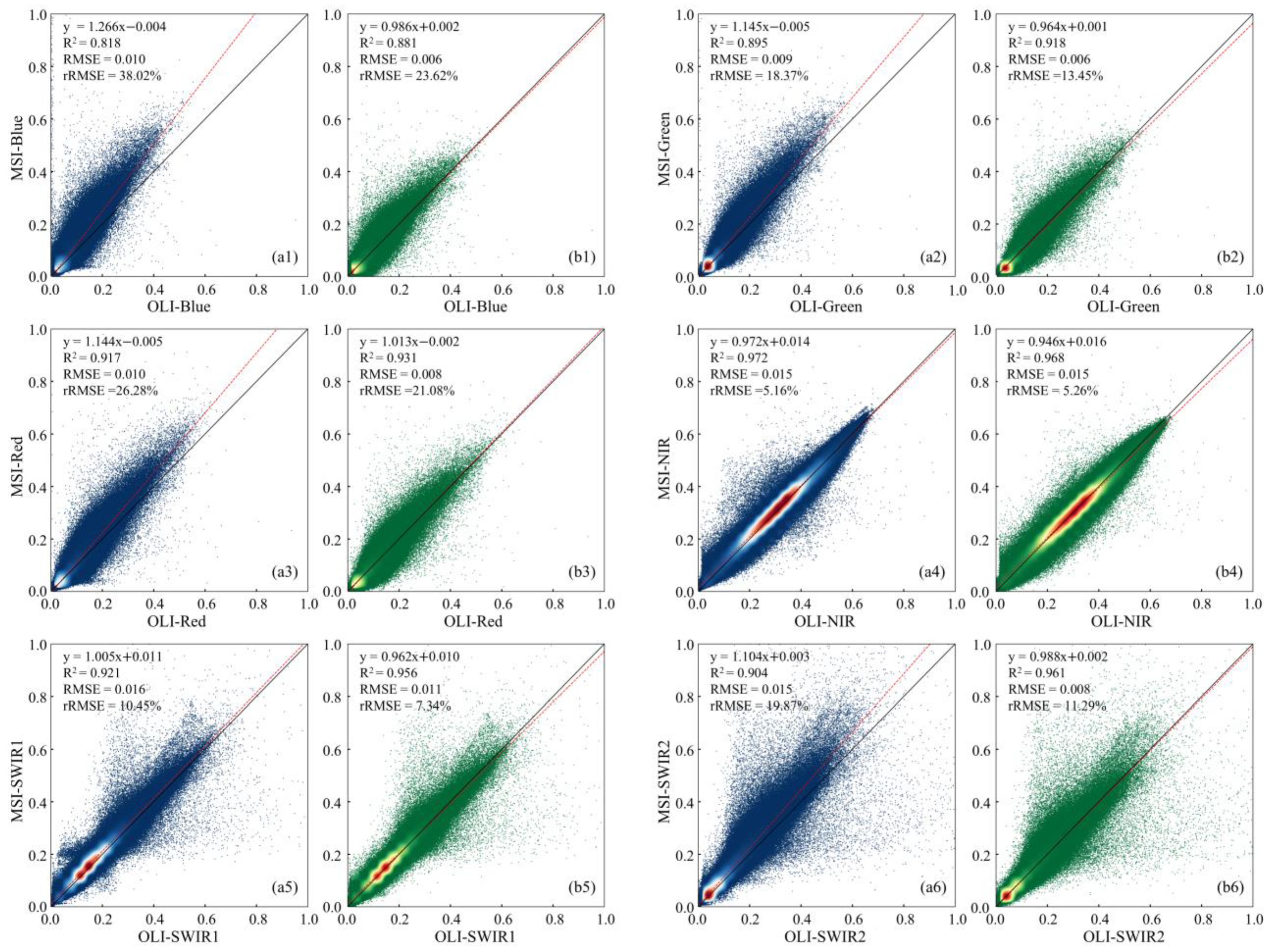
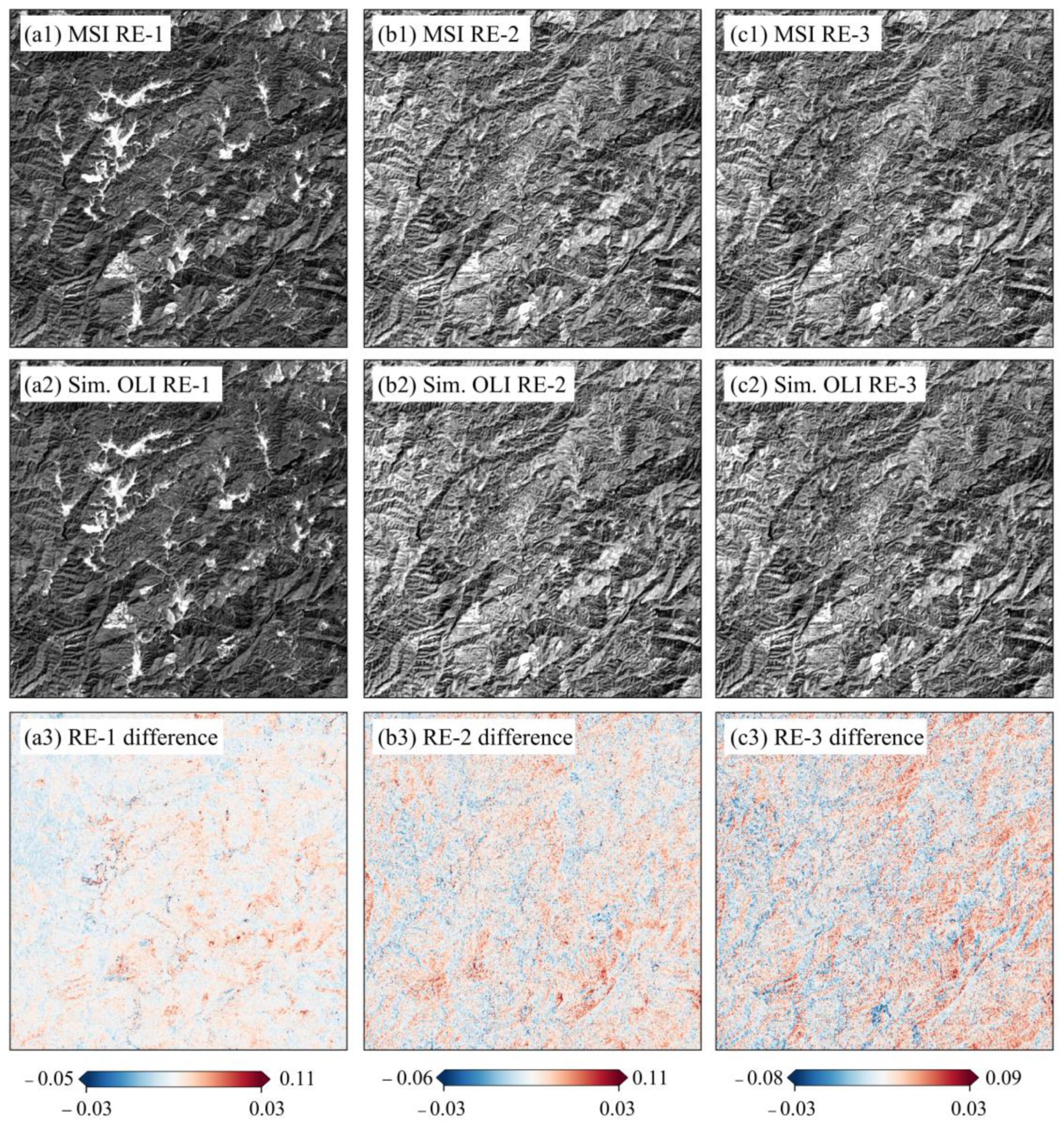

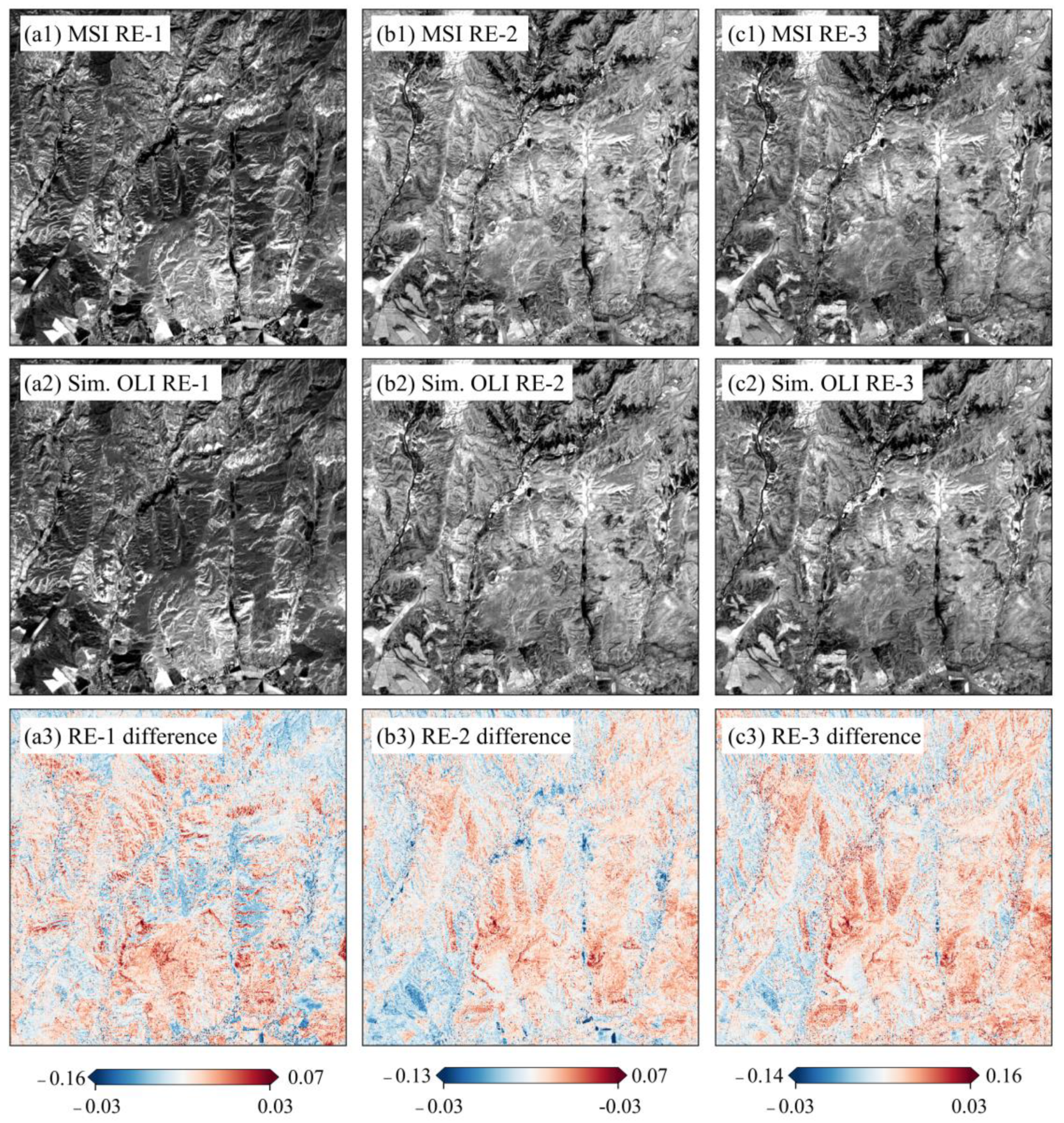

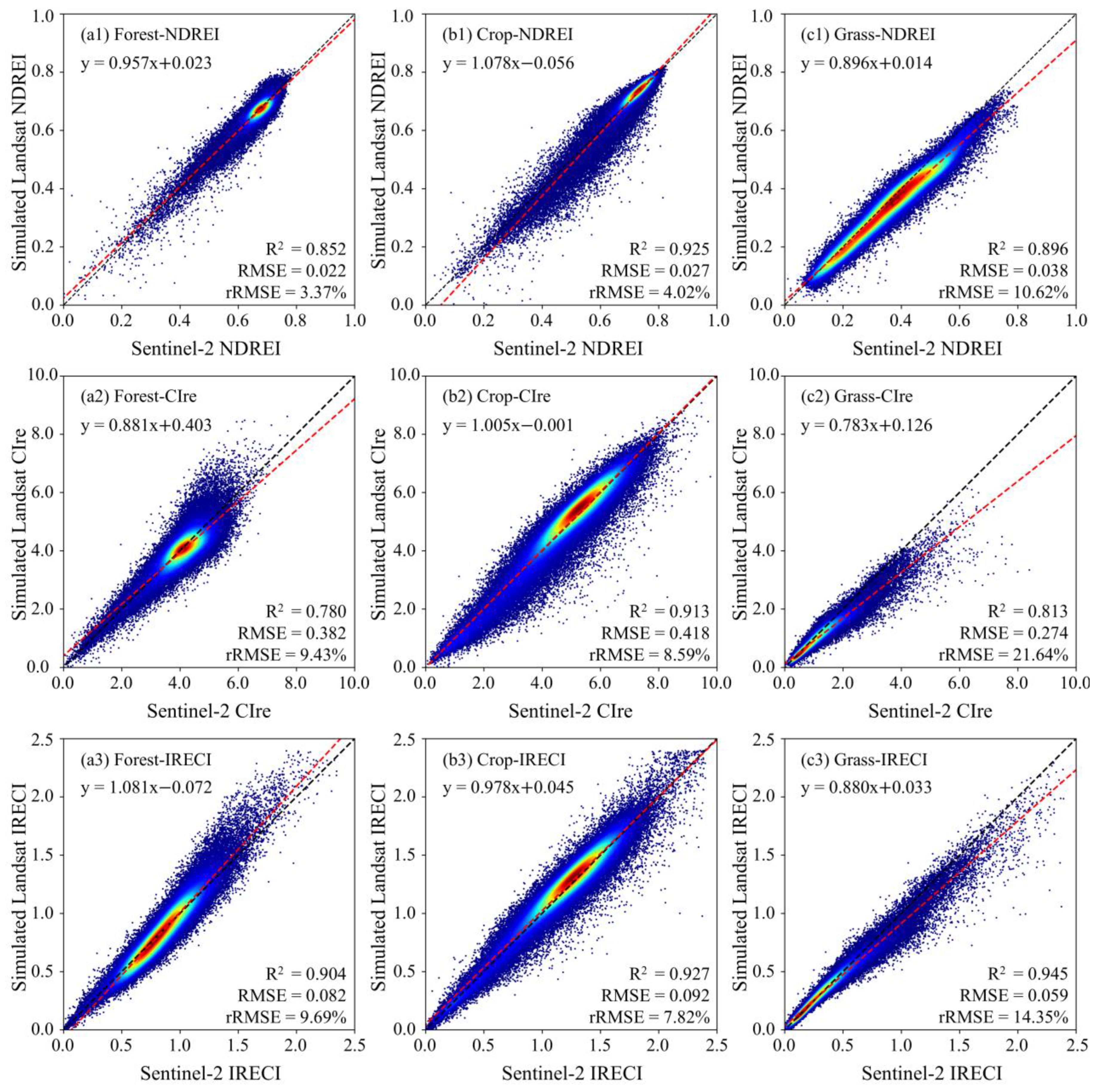
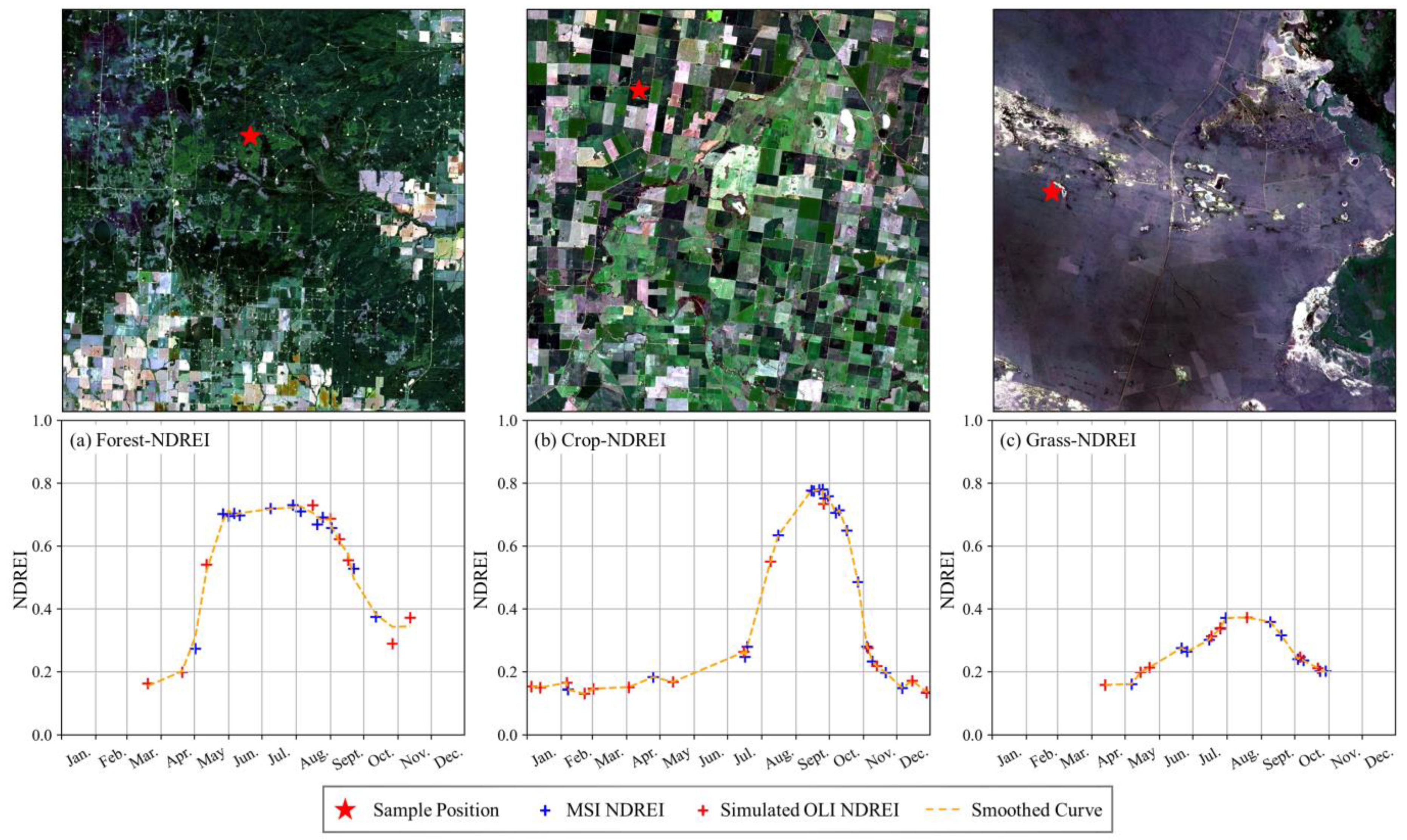

| ROI | Acquisition Date (dd/mm/yy) | Central Location (Latitude, Longitude) | Imaging Time (hh:mm:ss) | Dominant Land Covers | |
|---|---|---|---|---|---|
| Landsat-8 | Sentinel-2A | ||||
| 1 | 6 August 2018 | (47.440° N, 131.150° E) | 10:01:26 | 10:16:01 | Crop |
| 2 | 6 August 2018 | (47.265° N, 132.209° E) | 10:01:26 | 10:16:01 | Crop |
| 3 | 21 September 2023 | (37.507° N, 116.414° E) | 10:54:23 | 10:55:31 | Crop |
| 4 | 4 September 2020 | (33.802° N, 114.086° E) | 10:55:41 | 11:05:49 | Crop |
| 5 | 10 May 2022 | (37.839° S, 142.443° E) | 10:15:42 | 10:20:49 | Crop |
| 6 | 7 December 2021 | (27.782° N, 117.672° E) | 10:38:55 | 10:51:11 | Forest |
| 7 | 16 October 2023 | (25.724° N, 114.376° E) | 10:51:57 | 10:57:09 | Forest |
| 8 | 16 October 2023 | (24.778°N, 113.565° E) | 10:51:33 | 10:57:09 | Forest |
| 9 | 31 August 2023 | (46.154° N, 87.629° W) | 10:33:53 | 10:48:51 | Forest |
| 10 | 9 September 2023 | (55.544° N, 119.001° W) | 10:53:18 | 11:09:11 | Forest and grass |
| 11 | 9 September 2022 | (46.515° N, 129.484° E) | 10:08:51 | 10:15:39 | Forest and crop |
| 12 | 9 September 2022 | (41.773° N, 128.527° E) | 10:10:26 | 10:15:39 | Grass and forest |
| 13 | 21 June 2022 | (48.788°N,118.519° E) | 10:57:04 | 11:05:51 | Grass |
| 14 | 18 May 2024 | (44.084° N, 81.310° E) | 10:19:46 | 10:26:49 | Grass |
| 15 | 1 May 2023 | (52.808° N, 24.599° E) | 11:18:46 | 11:30:31 | Forest, crop, and grass |
| 16 | 14 August 2023 | (40.023° N, 44.863° E) | 10:37:42 | 10:46:19 | Forest, crop, and grass |
| 17 | 30 September 2023 | (39.130° N, 91.554° W) | 10:48:22 | 10:51:11 | Forest, crop, and grass |
| 18 | 25 October 2024 | (54.240° N, 113.522° W) | 10:28:59 | 10:53:59 | Forest, crop, and grass |
| Band Name | CW (nm) | Bandwidth (nm) | Spatial Resolution (m) | ||||
|---|---|---|---|---|---|---|---|
| MSI | OLI | MSI | OLI | MSI | OLI | MSI | OLI |
| B2: Blue | B2: Blue | 490 | 482 | 457–522 | 450–515 | 10 | 30 |
| B3: Green | B2: Green | 560 | 563 | 543–578 | 525–600 | 10 | 30 |
| B4: Red | B4: Red | 665 | 655 | 650–680 | 630–680 | 10 | 30 |
| B5: Red edge1 | - | 705 | - | 698–713 | - | 20 | 30 |
| B6: Red edge2 | - | 740 | - | 732–747 | - | 20 | 30 |
| B7: Red edge3 | - | 783 | - | 773–793 | - | 20 | 30 |
| B8a: Red edge4 | B5: NIR | 865 | 865 | 855–875 | 845–885 | 20 | 30 |
| B11: SWIR1 | B6: SWIR1 | 1610 | 1605 | 1565–1655 | 1560–1651 | 20 | 30 |
| B12: SWIR2 | B7: SWIR2 | 2190 | 2200 | 2100–2280 | 2100–2300 | 20 | 30 |
| Red-Edge Index | Formula | References |
|---|---|---|
| NDREI | (RE1 − NIR)/(RE1 + NIR) | [52] |
| CIre | NIR/RE1 − 1 | [53] |
| IRECI | (RE3 − R)/(RE1/RE2) | [54] |
| Algorithm | Statistical Measures | RE-1 (705 nm) | RE-2 (740 nm) | RE-3 (783 nm) |
|---|---|---|---|---|
| RR | R2 | 0.9771 | 0.9483 | 0.9735 |
| RMSE | 0.0082 | 0.0132 | 0.0130 | |
| rRMSE | 9.57% | 6.22% | 4.84% | |
| GBRT | R2 | 0.9807 | 0.9651 | 0.9764 |
| RMSE | 0.0076 | 0.0108 | 0.0122 | |
| rRMSE | 8.86% | 5.09% | 4.54% | |
| RFR | R2 | 0.9739 | 0.9646 | 0.9764 |
| RMSE | 0.0088 | 0.0109 | 0.0127 | |
| rRMSE | 10.27% | 5.14% | 6.41% |
| RE/REI | Forest | Crop | Grass | Stat. Range |
|---|---|---|---|---|
| RE-1 (705 nm) | 99.99% | 99.69% | 99.64% | (−0.03, 0.03) |
| RE-2 (740 nm) | 99.87% | 99.46% | 99.72% | (−0.03, 0.03) |
| RE-3 (783 nm) | 99.49% | 99.50% | 98.71% | (−0.03, 0.03) |
| REI | Forest | Crop | Grass | Stat. Range |
|---|---|---|---|---|
| NDREI | 99.81% | 98.76% | 98.72% | (−0.1, 0.1) |
| CIre | 98.23% | 97.17% | 99.99% | (−1.0, 1.0) |
| IRECI | 97.25% | 96.13% | 98.37% | (−0.2, 0.2) |
Disclaimer/Publisher’s Note: The statements, opinions and data contained in all publications are solely those of the individual author(s) and contributor(s) and not of MDPI and/or the editor(s). MDPI and/or the editor(s) disclaim responsibility for any injury to people or property resulting from any ideas, methods, instructions or products referred to in the content. |
© 2025 by the authors. Licensee MDPI, Basel, Switzerland. This article is an open access article distributed under the terms and conditions of the Creative Commons Attribution (CC BY) license (https://creativecommons.org/licenses/by/4.0/).
Share and Cite
Zhang, Y.; Fan, Z.; Yan, W.; Ge, C.; Sun, H. A Practical Method for Red-Edge Band Reconstruction for Landsat Image by Synergizing Sentinel-2 Data with Machine Learning Regression Algorithms. Sensors 2025, 25, 3570. https://doi.org/10.3390/s25113570
Zhang Y, Fan Z, Yan W, Ge C, Sun H. A Practical Method for Red-Edge Band Reconstruction for Landsat Image by Synergizing Sentinel-2 Data with Machine Learning Regression Algorithms. Sensors. 2025; 25(11):3570. https://doi.org/10.3390/s25113570
Chicago/Turabian StyleZhang, Yuan, Zhekui Fan, Wenjia Yan, Chentian Ge, and Huasheng Sun. 2025. "A Practical Method for Red-Edge Band Reconstruction for Landsat Image by Synergizing Sentinel-2 Data with Machine Learning Regression Algorithms" Sensors 25, no. 11: 3570. https://doi.org/10.3390/s25113570
APA StyleZhang, Y., Fan, Z., Yan, W., Ge, C., & Sun, H. (2025). A Practical Method for Red-Edge Band Reconstruction for Landsat Image by Synergizing Sentinel-2 Data with Machine Learning Regression Algorithms. Sensors, 25(11), 3570. https://doi.org/10.3390/s25113570







